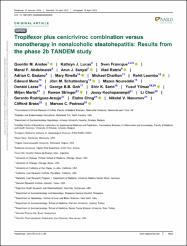Tropifexor plus cenicriviroc combination versus monotherapy in nonalcoholic steatohepatitis: Results from the phase 2b TANDEM study

View/
Access
info:eu-repo/semantics/openAccessDate
2023Author
Anstee, Quentin M.Lucas, Kathryn J.
Francque, Sven
Abdelmalek, Manal F.
Sanyal, Arun J.
Ratziu, Vlad
Gadano, Adrian C.
Rinella, Mary
Charlton, Michael
Loomba, Rohit
Mena, Edward
Schattenberg, Jörn M.
Noureddin, Mazen
Lazas, Donald
Goh, George B.B.
Sarin, Shiv K.
Yılmaz, Yusuf
Martic, Miljen
Stringer, Rowan
Kochuparampil, Jossy
Chen, Li
Rodriguez-Araujo, Gerardo
Chng, Elaine
Naoumov, Nikolai V.
Brass, Clifford
Pedrosa, Marcos C.
Metadata
Show full item recordCitation
Anstee, Q. M., Lucas, K. J., Francque, S., Abdelmalek, M. F., Sanyal, A. J., Ratziu, V., Gadano, A. C., Rinella, M., Charlton, M., Loomba, R., Mena, E., Schattenberg, J. M., Noureddin, M., Lazas, D., Goh, G. B. B., Sarin, S. K., Yilmaz, Y., Martic, M., Stringer, R., Kochuparampil, J., … Pedrosa, M. C. (2023). Tropifexor plus cenicriviroc combination versus monotherapy in nonalcoholic steatohepatitis: Results from the phase 2b TANDEM study. Hepatology (Baltimore, Md.), 78(4), 1223–1239. https://doi.org/10.1097/HEP.0000000000000439Abstract
Background and Aims: With distinct mechanisms of action, the combination of tropifexor (TXR) and cenicriviroc (CVC) may provide an effective
treatment for NASH. This randomized, multicenter, double-blind, phase 2b
study assessed the safety and efficacy of TXR and CVC combination,
compared with respective monotherapies.
Approach and Results: Patients (N = 193) were randomized 1:1:1:1 to
once-daily TXR 140 μg (TXR140), CVC 150 mg (CVC), TXR 140 μg + CVC
150 mg (TXR140 + CVC), or TXR 90 μg + CVC 150 mg (TXR90 + CVC) for 48
weeks. The primary and secondary end points were safety and histological
improvement, respectively. Rates of adverse events (AEs) were similar
across treatment groups. Pruritus was the most frequently experienced AE,
with highest incidence in the TXR140 group (40.0%). In TXR and combination
groups, alanine aminotransferase (ALT) decreased from baseline to 48
weeks (geometric mean change: −21%, TXR140; −16%, TXR140 + CVC;
−13%, TXR90 + CVC; and +17%, CVC). Reductions in body weight observed
at week 24 (mean changes from baseline: TXR140, −2.5 kg; TXR140 + CVC,
−1.7 kg; TXR90 + CVC, −1.0 kg; and CVC, −0.1 kg) were sustained to week
48. At least 1-point improvement in fibrosis stage/steatohepatitis resolution
without worsening of fibrosis was observed in 32.3%/25.8%, 31.6%/15.8%,
29.7%/13.5%, and 32.5%/22.5% of patients in the TXR140, CVC, TXR140 +
CVC, and TXR90 + CVC groups, respectively.
Conclusions: The safety profile of TXR + CVC combination was similar to
respective monotherapies, with no new signals. TXR monotherapy showed
sustained ALT and body weight decreases. No substantial incremental
efficacy was observed with TXR + CVC combination on ALT, body weight, or
in histological end points compared with monotherapy

















